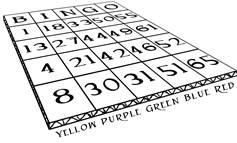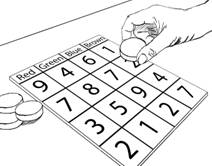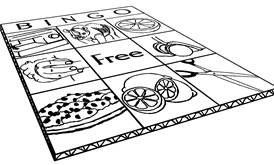renewal cycles. Complete
some now & some later.
and Get 25% off
the Total price!
Buy 3 Courses
and Get 30% off
the Total price!
Buy 4 Courses
and Get 35% off
the Total price!
| Create Account | Login | |

Section 21
Bingo Adaptations
Table of Contents | NCCAP/NCTRC CE Booklet
Bingo Adaptations
Color Column Bingo
(The last track of the DVD that accompanied this course contains slide(s) illustrating implementation of this activity.)
 Color Column Bingo is exactly what it sounds like, and, as the illustration indicates, each column has a color to facilitate the resident finding the number. If you have a few residents who are alert enough to play Bingo, sometimes unfortunately they look over the entire card of twenty-five numbers for the number just called. Thus, if you have a standard Bingo game, observe your resident's ability to organize a two-step process in their mind. In short, when, for example, B-8 is called, do you have a resident who has the organizational skills to first look in the B column, and secondly to look for the number 8 only in the B column?
Color Column Bingo is exactly what it sounds like, and, as the illustration indicates, each column has a color to facilitate the resident finding the number. If you have a few residents who are alert enough to play Bingo, sometimes unfortunately they look over the entire card of twenty-five numbers for the number just called. Thus, if you have a standard Bingo game, observe your resident's ability to organize a two-step process in their mind. In short, when, for example, B-8 is called, do you have a resident who has the organizational skills to first look in the B column, and secondly to look for the number 8 only in the B column?
However, instead do you have residents who look randomly over all 25 squares for the number 8? They oftentimes miss it in the confusion of checking so many numbers. For this resident, you might assess if they are receptive to using a Color Column Bingo Card. You make a series of special cards for them. The reason I say a series of cards rather than one card is, as you may be aware, part of the fun of Bingo for some residents is choosing a "lucky" card. But I find when a resident's mental capability starts to slip to this level, they become less aware of these subtleties of the game, such as trying to choose a "lucky" card. But in case they have a preference, it might be a good idea to make several Column Bingo Cards.
Construction: 9" x12" cards are cut for corrigated cardboard. Glue five strips of construction paper to the cardboard. The colors I used were yellow for the B column; purple for the I column; green for the N column; blue for the G column; and red for the O column. Use a black marker pen and ruler to make the lines and numbers. To make sure the numbers are in the right columns, copy the pattern from existing cards. When your volunteer calls the numbers, she now calls out, for example, in the yellow column B-8; in the blue column G-51, etc.
Solving your Dominant Resident Problem: Some of my alert domineering residents didn't like the color calling at first, because they had the regular cards. I felt they did not want to think of themselves as being so impaired in the future to need this adaptaton themselves. To deal with their complaints, I stated, "I am required by the state regulations to make adaptations to my activities to meet as many residents needs as possible." I find "blaming" it on a third party works quite well… sometimes. The management series offered by the Healthcare Training Institute has a DVD course providing skills to deal with these Domineering Residents that tend to try to control your Program.
Approach: To provide resident with adaptive card…
Residents with whom to try Color Column Bingo
| Resident | Who will gather materials and/or construct project? |
Staff /Volunteer to work with resident? When? |
|
|
|
|
|
|
|
|
|
Culture Change Implementation: Place Color Column Bingo in labeled Activity Project Bag left in resident’s room for CNA, etc. use.
Single-Digit Bingo
 Single-Digit Bingo is exactly what it sounds like. However, it cannot be played simulataneously with your regular Bingo game, as with the Color Column Bingo described in the preceeding section. With Single-Digit Bingo, you only have three four columns, and three or four rows. In the nine to sixteen boxes, you use a marker pen on construction paper that has been pasted to corrugated cardboard to randomly write the numbers from one to nine. Since there are fewer numbers, and fewer combinations, the game becomes rather short, lending itself well to residents with a short attention span. As in the Picture Bingo to be described next, the caller has cards face-down with the numbers from one to nine on them. The more complicated version is illustrated at the right, with four columns and four rows, for more alert residents. You could also select these numbers from a deck of cards. Thus the caller would say, "Seven. If you have a seven on your card, cover it up." Squares are cut from poster board or corrugated cardboard depending on the thumb and index finger grasping ability of your residents, to cover up the numbers. You can readily see the benefit of Single-Digit Bingo for residents that are starting to transpose numbers or cover up the number twenty-three when the number two is called, because all they notice is the two in the number twenty-three. However, clearly the main drawback is you cannot have a Bingo game with one player. Thus you need to assess if you have as least two residents in your facility for Single-Digit Bingo. This, as well as picture Bingo, to be described next, is a good activity for a volunteer who wants the structure of working with a group.
Single-Digit Bingo is exactly what it sounds like. However, it cannot be played simulataneously with your regular Bingo game, as with the Color Column Bingo described in the preceeding section. With Single-Digit Bingo, you only have three four columns, and three or four rows. In the nine to sixteen boxes, you use a marker pen on construction paper that has been pasted to corrugated cardboard to randomly write the numbers from one to nine. Since there are fewer numbers, and fewer combinations, the game becomes rather short, lending itself well to residents with a short attention span. As in the Picture Bingo to be described next, the caller has cards face-down with the numbers from one to nine on them. The more complicated version is illustrated at the right, with four columns and four rows, for more alert residents. You could also select these numbers from a deck of cards. Thus the caller would say, "Seven. If you have a seven on your card, cover it up." Squares are cut from poster board or corrugated cardboard depending on the thumb and index finger grasping ability of your residents, to cover up the numbers. You can readily see the benefit of Single-Digit Bingo for residents that are starting to transpose numbers or cover up the number twenty-three when the number two is called, because all they notice is the two in the number twenty-three. However, clearly the main drawback is you cannot have a Bingo game with one player. Thus you need to assess if you have as least two residents in your facility for Single-Digit Bingo. This, as well as picture Bingo, to be described next, is a good activity for a volunteer who wants the structure of working with a group.
The key is the thickness!
I am sure you've noticed by now that I suggest the use of corrugated cardboard in several activities. First of all, you may ask, “What is corrugated cardboard?” The word "corrugated" means ribbed. Corrugated cardboard is made up of three layers. There is a bottom layer, a wavy layer, and a top layer. It is the kind of cardboard most brown shipping boxes are made from, and is readily available. However, poster board is just one compressed piece. There is a major thickness difference between corrugated cardboard and poster board. Clearly, construction paper is thinner than poster board and normal typing paper is the thinnest. I am very well aware that it is much, much easier to cut poster board, construction paper, or typing paper. However, it can be somewhat difficult to cut corrugated cardboard from a box.
So why do I continually recommend items be constructed from corrugated cardboard? The key is the thickness. Ask yourself, if you had a stiff thumb and index finger, would it be easier for you to pick up a sheet of paper or a gallon milk bottle cap? I think you get my point. Even though the corrugated cardboard makes the construction of your project more difficult, the resident will experience much more successful manipulating and moving around a Bingo card constructed from rigid, thick corrugated cardboard, as a opposed to one that is constructed from thin, flimsy, but easy-to-cut poster board. Obviously, poster board is more aesthetically pleasing, with its smooth surface and variety of beautiful colors; but what a pain to take brown cardboard boxes, have to glue construction paper over them, and cover this with clear contact paper! However, don't overlook residents who are struggling with stiff thumb and index fingers to move around thin flimsy items. Ask yourself, “What can I do to add thickness to this item?” Maybe you can come up with another idea than mine of corrugated cardboard.
Residents with whom to try Single-Digit Bingo
| Resident | Who will gather materials and/or construct project? |
Staff /Volunteer to work with resident? When? |
|
|
|
|
|
|
|
|
|
Culture Change Implementation: Place Single Digit Bingo in an Activity Project Bag left in resident’s room for CNA, volunteer, etc. use.
Picture Bingo
If you have two or three residents who used to play Bingo, but they no longer can recognize numbers so Color Column Bingo and Single-Digit Bingo are no longer appropriate, you might try a Picture Bingo game. As with Single-Digit Bingo, this is a separate game from your regular Bingo game. However, the caller has word cards face down in front of him or her. The caller turns up a word card and says "Scissors, if you have a pair of scissors on your card, cover it up." Usually residents at this level require assistance in finding the picture and covering it up.
 However, I find this game has the greatest success if each card is custom made, so to speak, for each resident. In other words, have the resident involved in selecting the magazine pictures that are cut and glued to his or her card. Rarely do residents of this level have the ability to actually cut the pictures themselves. So the resident is involved in selecting pictures that are the most meaningful or interesting to him or her. “Person Appropriate?” You bet.
However, I find this game has the greatest success if each card is custom made, so to speak, for each resident. In other words, have the resident involved in selecting the magazine pictures that are cut and glued to his or her card. Rarely do residents of this level have the ability to actually cut the pictures themselves. So the resident is involved in selecting pictures that are the most meaningful or interesting to him or her. “Person Appropriate?” You bet.
Here's how the selection process can work. You say to your resident, "Frieda, which one of these pictures do you like the best?" and then you discuss the picture. I find if I show Frieda only two or three pictures at a time, I have better luck holding her attention and getting her to show a preference. This selection process is great Reminiscence Therapy and can take several sessions to select the eight pictures for their Picture Bingo card.
| Goal: To select pictures for Picture Bingo card and discuss past memories… |
Goal: To play Picture Bingo with assistance… |
Residents with whom to try Picture Bingo
| Resident | Who will gather materials and/or construct project? |
Staff /Volunteer to work with resident? When? |
|
|
|
|
|
|
|
|
|
Culture Change Implementation: Place Picture Bingo in labeled Activity Project Bag left in resident’s room for CNA, volunteer, etc. use.
NCCAP/NCTRC CE Booklet
Forward to Section 22
Back to Section 20
Table of Contents
Top


